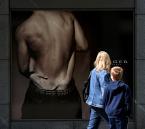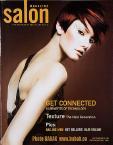Beauty (Mis)represented: The Effects on Society
"When teenagers and women look at these pictures in magazines, they end up feeling unhappy with themselves… If people knew they had to describe what they had altered, it might make them less likely to do it. These photos can lead people to believe in realities that very often, do not exist." — Jo Swinson, a British member of Parliament from the Liberal Democratic Party.
Women are dying to look perfect.
The female body is reflected and portrayed in the omnipresent media as an object of desire. Stick thin models are used in advertisements, which are then airbrushed and photo-shopped to produce an unattainable image of beauty-- and women around the world strive to fit into it. While many realize that mass media is establishing this narrow and unrealistic standard of beauty, the detrimental effects on society are not so obvious, affecting women and men, teenagers and adults, average individuals as well as celebrities. Furthermore, what often goes overlooked is the severe psychological and physical dangers behind having these ultra-thin bodies. Females are left to think that becoming stick-thin is all glamorous and non-consequential.
Girls, girls, girls
Women tend to be the most severely and commonly affected group in society from the media’s standard of beauty. From an early age, they are exposed to the use of super thin cultural icons representing ‘feminine beauty.’ Constantly being compared to computer-manipulated images of already thin and cosmetically ideal models, women of all ages develop and suffer from body dissatisfaction, depression, anorexia, bulimia, perfectionism, low self-esteem, and other psychological damages. The drive for thinness inherit to many women is a learned behavior that media sources, especially magazines, explain how to achieve. Women are expected to have certain body characteristics that just aren’t realistic: not everyone has large breasts, a small waist, and long legs. Girls also grow up believing that they should fit into some sort of category, not appreciating diversity and uniqueness that truly makes someone beautiful. Although at some point it becomes apparent that the majority of women do not fit into media’s definition of beautiful, psychological damages are already incurred and the time spent unhappy cannot be given back.
Men…free from Media Pressures?
Yes, it is true that men are less likely to starve themselves than females, but they are experiencing body image dissatisfaction today at the highest rate yet. For years media has created the illusion to men that women should fit the narrowly defined standard of media to be attractive and beautiful, constraining their ability to see the true, unique beauty of women. Recently however, the media has directly targeted men by defining the ideal (yet unattainable) male as youthful, masculine, successful, and attractive. The pressure to fit this standard is causing men to develop disorders and tendencies that women have experienced for years. The most common disorder developed by men is termed as “exercise bulimia,” referring to excessive amounts of daily exercise men perform to burn all the calories eaten in the day. Men also engage in steroids, eating disorders, cosmetic surgery- both facial and genital, and compulsive dieting in pursuit of youth, success, and sex appeal. Men are retouched with make-up and products to present the perfect male, even though the use of cosmetics contradicts this manly image. They are then digitally retouched, ensuring the impossibility for men to achieve this standard. Needless to say, women, it’s not just us who must deal with this severe, media-constructed pressure!
Flawless Celebrities
All celebrities are perfect and aren’t affected by the media’s construct of beauty, right? Wrong! Celebrities also brutally suffer because they are heavily scrutinized if they stray from this standard. If they gain weight, suddenly their life is out of control and won’t get back on track until they lose it, as depicted by the media. Just this summer, a picture of a seemingly heavier Jessica Simpson appeared throughout many magazines, television shows, and websites, paired with paragraphs on why her life was in shambles. The media constantly portrays the message that success comes harder to celebrities who are not ultra-thin. Additionally, celebrities are constantly compared with other, more ideal celebrities under magazine headings such as ‘The Best and Worst Beach Bods.’ Models’ careers depend on how skinny they are, triggering high-pressures so severe they can cause physical damages and sometimes result in death. Celebrities may appear to be flawless to everyday individuals, but they are facing the same detrimental effects and pressures from the media that we are.
What about the consumer??
Consumers are yet another group who are negatively affected from the media. Photographic techniques blur the realistic nature of images used in advertisements and other media sources, falsely allowing consumers to believe that the models displayed are realistic representations of actual people rather than computer-manipulated, carefully constructed images. As Shari Graydon states, “If we can’t trust that the images we’re looking at reflect reality, why should we credit the words that appear alongside them with any greater truth?” Consumers have the right to expect authenticity from images published in media sources. Consumers suffer as they are falsely deceived into believing that certain products lead to the results portrayed in the advertisement.
"In a L'Oreal ad, while claiming that the mascara could give users “up to 60 percent longer lashes,” the ads failed to disclose that Ms. Cruz, the featured actress, was wearing fake ones." -Eric Pfanner of the New York Times
Facts
-About 1 in 100 adolescent girls suffers from anorexia.
-More than 90% of anorexics are female.
-About 3 percent of adolescent girls suffer from bulimia.
-Avoiding exposure to certain media sources can have a positive impact on the way women feel about themselves.
-Mass media may be the most potent and pervasive communicators of sociocultural standards.
-Less than 10% of women appearing on television are overweight.
-Interpersonal attraction to thin media personalities is related to disordered eating above and beyond the influence of mere exposure to media.
-In 2001, the vast majority of cosmetic surgeries were performed on women, but:
136,000 men reshaped their noses
48,663 underwent liposuction procedures
44,726 tightened the skin on their eyelids
27,817 tried hair transplantations
18,548 had their breasts reduced
106,056 injected botulinim toxin into their foreheads to forestall wrinkling
Women are dying to look perfect.
The female body is reflected and portrayed in the omnipresent media as an object of desire. Stick thin models are used in advertisements, which are then airbrushed and photo-shopped to produce an unattainable image of beauty-- and women around the world strive to fit into it. While many realize that mass media is establishing this narrow and unrealistic standard of beauty, the detrimental effects on society are not so obvious, affecting women and men, teenagers and adults, average individuals as well as celebrities. Furthermore, what often goes overlooked is the severe psychological and physical dangers behind having these ultra-thin bodies. Females are left to think that becoming stick-thin is all glamorous and non-consequential.
Girls, girls, girls
Women tend to be the most severely and commonly affected group in society from the media’s standard of beauty. From an early age, they are exposed to the use of super thin cultural icons representing ‘feminine beauty.’ Constantly being compared to computer-manipulated images of already thin and cosmetically ideal models, women of all ages develop and suffer from body dissatisfaction, depression, anorexia, bulimia, perfectionism, low self-esteem, and other psychological damages. The drive for thinness inherit to many women is a learned behavior that media sources, especially magazines, explain how to achieve. Women are expected to have certain body characteristics that just aren’t realistic: not everyone has large breasts, a small waist, and long legs. Girls also grow up believing that they should fit into some sort of category, not appreciating diversity and uniqueness that truly makes someone beautiful. Although at some point it becomes apparent that the majority of women do not fit into media’s definition of beautiful, psychological damages are already incurred and the time spent unhappy cannot be given back.
Men…free from Media Pressures?
Yes, it is true that men are less likely to starve themselves than females, but they are experiencing body image dissatisfaction today at the highest rate yet. For years media has created the illusion to men that women should fit the narrowly defined standard of media to be attractive and beautiful, constraining their ability to see the true, unique beauty of women. Recently however, the media has directly targeted men by defining the ideal (yet unattainable) male as youthful, masculine, successful, and attractive. The pressure to fit this standard is causing men to develop disorders and tendencies that women have experienced for years. The most common disorder developed by men is termed as “exercise bulimia,” referring to excessive amounts of daily exercise men perform to burn all the calories eaten in the day. Men also engage in steroids, eating disorders, cosmetic surgery- both facial and genital, and compulsive dieting in pursuit of youth, success, and sex appeal. Men are retouched with make-up and products to present the perfect male, even though the use of cosmetics contradicts this manly image. They are then digitally retouched, ensuring the impossibility for men to achieve this standard. Needless to say, women, it’s not just us who must deal with this severe, media-constructed pressure!
Flawless Celebrities
All celebrities are perfect and aren’t affected by the media’s construct of beauty, right? Wrong! Celebrities also brutally suffer because they are heavily scrutinized if they stray from this standard. If they gain weight, suddenly their life is out of control and won’t get back on track until they lose it, as depicted by the media. Just this summer, a picture of a seemingly heavier Jessica Simpson appeared throughout many magazines, television shows, and websites, paired with paragraphs on why her life was in shambles. The media constantly portrays the message that success comes harder to celebrities who are not ultra-thin. Additionally, celebrities are constantly compared with other, more ideal celebrities under magazine headings such as ‘The Best and Worst Beach Bods.’ Models’ careers depend on how skinny they are, triggering high-pressures so severe they can cause physical damages and sometimes result in death. Celebrities may appear to be flawless to everyday individuals, but they are facing the same detrimental effects and pressures from the media that we are.
What about the consumer??
Consumers are yet another group who are negatively affected from the media. Photographic techniques blur the realistic nature of images used in advertisements and other media sources, falsely allowing consumers to believe that the models displayed are realistic representations of actual people rather than computer-manipulated, carefully constructed images. As Shari Graydon states, “If we can’t trust that the images we’re looking at reflect reality, why should we credit the words that appear alongside them with any greater truth?” Consumers have the right to expect authenticity from images published in media sources. Consumers suffer as they are falsely deceived into believing that certain products lead to the results portrayed in the advertisement.
"In a L'Oreal ad, while claiming that the mascara could give users “up to 60 percent longer lashes,” the ads failed to disclose that Ms. Cruz, the featured actress, was wearing fake ones." -Eric Pfanner of the New York Times
Facts
-About 1 in 100 adolescent girls suffers from anorexia.
-More than 90% of anorexics are female.
-About 3 percent of adolescent girls suffer from bulimia.
-Avoiding exposure to certain media sources can have a positive impact on the way women feel about themselves.
-Mass media may be the most potent and pervasive communicators of sociocultural standards.
-Less than 10% of women appearing on television are overweight.
-Interpersonal attraction to thin media personalities is related to disordered eating above and beyond the influence of mere exposure to media.
-In 2001, the vast majority of cosmetic surgeries were performed on women, but:
136,000 men reshaped their noses
48,663 underwent liposuction procedures
44,726 tightened the skin on their eyelids
27,817 tried hair transplantations
18,548 had their breasts reduced
106,056 injected botulinim toxin into their foreheads to forestall wrinkling









